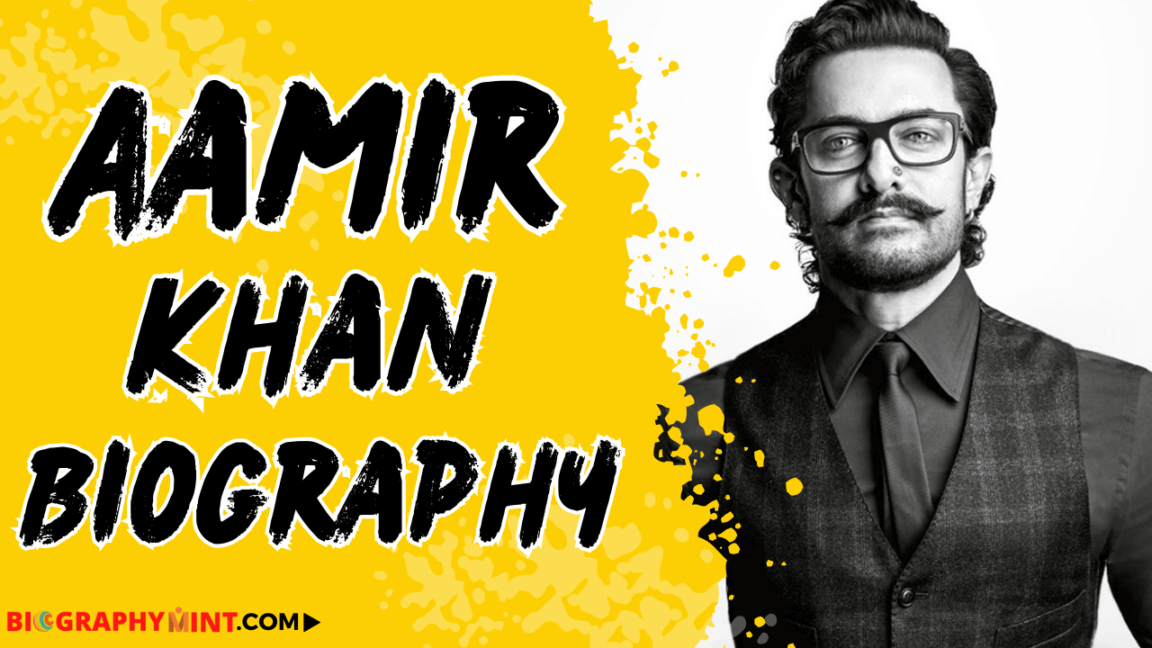Introduction
Aamir Khan stands as one of Bollywood’s most influential and versatile actors. Known for his meticulous approach to roles and his commitment to social causes, Khan has left an indelible mark on Indian cinema. His illustrious career spans over three decades, during which he has delivered numerous critically acclaimed and commercially successful films, earning him the moniker “Mr. Perfectionist” in the industry.
Khan’s journey in the world of cinema goes beyond acting. He has made a name for himself as a filmmaker, producer, and television host. His Aamir Khan Productions has backed several thought-provoking films that have sparked important conversations in society. From his debut as a child actor to becoming one of the most respected figures in Bollywood, Aamir Khan’s biography is a testament to his dedication, talent, and the impact he has had on Indian cinema and society at large.
Early Life and Background
Family Heritage
Aamir Khan, born Mohammed Aamir Hussain Khan on March 14, 1965, in Bombay (now Mumbai), India, comes from a family deeply rooted in the film industry . His father, Tahir Hussain, was a film producer, while his mother, Zeenat Hussain, supported the family’s creative endeavors . Khan’s family tree extends to notable figures in Indian cinema, including his uncle Nasir Hussain, a leading producer-director in the 1970s, and his cousin Mansoor Khan, also a director.
The Khan family’s heritage is a tapestry of diverse cultural influences. Aamir’s paternal grandfather was a schoolteacher from a Pashtun zamindar background, while his paternal grandmother had Arab roots tracing back to Jeddah, Saudi Arabia . Interestingly, Khan’s paternal grandmother was a niece of Maulana Abul Kalam Azad, a prominent Indian independence activist and the country’s first Minister of Education . This connection has inspired Khan to express his wish to make a movie about Maulana Azad.
Khan’s family ties extend beyond the film industry. His cousin, Najma Heptulla, served as the 16th Governor of Manipur and is the grand-niece of Maulana Azad . The family’s artistic legacy continues with Khan’s nephew, Imran Khan, who has also made a name for himself in the Hindi film industry.
Childhood and Education
Growing up in Mumbai, Aamir Khan’s childhood was marked by a blend of academic pursuits and artistic exploration. He began his education at J.B. Petit School for his pre-primary years . From first to eighth grade, he attended St. Anne’s High School in Bandra, later transferring to Bombay Scottish School in Mahim for his ninth and tenth grades.
Despite his family’s involvement in the film industry, Khan’s parents initially hoped he would pursue a more conventional career path, such as engineering or medicine . However, Khan’s interests lay elsewhere. He excelled in sports, particularly tennis, becoming a state-level champion . In his own words, he was “much more into sports than studies”.
Aamir Khan’s academic journey continued at Mumbai’s Narsee Monjee College, where he completed his twelfth grade . However, his childhood was not without challenges. Khan has described this period as “tough” due to financial difficulties his family faced, as his father’s film productions were often unsuccessful.
Early Interest in Acting
Aamir Khan’s passion for acting manifested early in his life. At the tender age of eight, he made his first on-screen appearance in “Yaadon Ki Baaraat” (1973), which is considered the first masala film in Bollywood . The following year, he portrayed the younger version of Mahendra Sandhu’s character in “Madhosh”.
A pivotal moment in Aamir Khan’s journey came at the age of sixteen when he got involved in the experimental process of making a 40-minute silent film called “Paranoia” Directed by his school friend Aditya Bhattacharya, the film featured Khan in the lead role alongside actors Neena Gupta and Victor Banerjee . This experience, which had to be kept secret from his parents due to their reservations about a film career, ignited Khan’s passion for cinema .
Following this, Aamir Khan joined a theater group called Avantar, where he worked backstage for over a year before making his stage debut in a Gujarati play, “Kesar Bina,” at Prithvi Theater He went on to act in two Hindi plays and one English play titled “Clearing House” .
After completing high school, Khan made the bold decision to discontinue his studies and instead work as an assistant director to Nasir Hussain on the Hindi films “Manzil Manzil” and “Zabardast” . This early exposure to the behind-the-scenes aspects of filmmaking would prove invaluable in shaping his future career as one of India’s most accomplished actors.
Physical Attributes
Height and Weight
Aamir Khan, known for his versatile roles in Bollywood, stands at a height of approximately 168 cm (5 feet 6 inches) . His weight fluctuates depending on the requirements of his roles, but he typically maintains a weight of around 70 kg (154 lbs). However, for specific film roles, Khan has demonstrated remarkable physical transformations. For instance, in preparation for his role in “Dangal,” he gained over 60 pounds, reaching 38 percent body fat . Impressively, he then lost this weight and achieved a muscular physique with single-digit body fat in less than six months.
Body Measurements
Aamir Khan’s dedication to fitness is evident in his physical measurements. His chest measures approximately 40 inches, his waist 30 inches, and his biceps 13 inches. These measurements contribute to his lean and muscular appearance, particularly noticeable in roles that require a more athletic physique. In the film “Dangal,” Khan’s body transformation resulted in broad, round shoulders, muscular arms, and square pecs, giving him the appearance of a high-level Olympic wrestler.
Fitness Regimen
Aamir Khan’s fitness regimen is at the heart of his awe-inspiring physical transformations, carefully designed for each character he portrays. He views fitness as an all-encompassing experience, blending physical exercises, a well-balanced diet, and a serene mind. His workout routine typically begins with a comprehensive warm-up to avoid injuries, followed by a circuit of core workouts targeting six muscle groups, with additional focus on abdominal exercises.
Aamir Khan’s dedication to fitness is evident in his rigorous schedule. He dedicates six days a week to intense workouts, reserving Sundays for recovery and rest. His routine includes a variety of activities such as cycling, trekking, tennis, and weight loss training. In an interview, Khan revealed that he followed a strict workout routine with a stable calorie intake of 1500 per day during one of his transformations.
To achieve effective fat loss, Khan adheres to a crucial balanced diet guided by an expert nutritionist. He emphasizes the importance of motivation and has developed strategies to protect himself from demotivation during challenging fitness journeys.
Aamir Khan’s physical transformations for various film roles have been nothing short of remarkable. For the film “Ghajini” (2008), he made headlines with his chiseled eight-pack abs, which became a sensation among youth and other actors in the industry. In contrast, for “3 Idiots” (2009), he shed this muscular physique to become lean and lanky, better suiting the role of a college student.
His transformation for “PK” (2014) saw him lose several kilos to achieve the perfect shape for his character, an alien. Perhaps his most dramatic change came for “Dangal” (2016), where he gained significant weight to play an older wrestler, sporting a salt and pepper look that left audiences spellbound.
More recently, for “Thugs of Hindostan” (2018), Khan appeared with a fit and agile body, complemented by a nose pin, earrings, messy curly hair, and a handlebar mustache. In “Laal Singh Chaddha” (2020), he once again transformed his appearance, this time growing a full beard and long hair to play a Sardar.
It’s important to note that while Khan’s fitness regimen has produced impressive results, it’s tailored to his specific needs and goals. Anyone considering adopting a similar routine should first consult a doctor, as individual body requirements and health conditions can vary significantly.
Acting Career
Debut and Initial Struggles
Aamir Khan’s journey in the film industry began with a serendipitous encounter. As a shy and awkward teenager, he was approached by Aditya Bhattacharya to act in a short film for a festival . This experience ignited Khan’s passion for acting, leading him to pursue it as a profession despite initial reservations from his family .
Khan’s first appearance on screen was as a child actor in “Yaadon Ki Baaraat” (1973) . However, he considers his adult debut to be in the film “Holi” (1984), directed by Ketan Mehta . This low-budget experimental film, based on a play by Mahesh Elkunchwar, dealt with the practice of ragging in India . Khan portrayed a rowdy college student, a role that The New York Times described as “very decently and exuberantly performed” despite its insignificance.
Breakthrough Roles
Khan’s breakthrough came with “Qayamat Se Qayamat Tak” (1988), where he played the lead role opposite Juhi Chawla . This tale of unrequited love and parental opposition catapulted both Khan and Chawla to stardom . The film was a major commercial success, earning Khan his first Filmfare Award for Best Male Debut.
Following this, Khan appeared in “Raakh” (1989), a crime thriller that, despite poor box office performance, received critical acclaim . His performances in both “Qayamat Se Qayamat Tak” and “Raakh” earned him a National Film Award – Special Jury Award / Special Mention.
Critical Acclaim and Box Office Success
Throughout the 1990s, Khan’s career flourished with a string of box office hits. Notable among these were “Dil” (1990), a romantic drama that emerged as the highest-grossing Hindi film of the year, and “Hum Hain Rahi Pyar Ke” (1993), which also marked his debut as a screenwriter.
Khan’s versatility as an actor became increasingly evident as he took on diverse roles. In “Raja Hindustani” (1996), he portrayed a hotheaded tourist guide, a performance that showcased his ability to tackle challenging emotions. His role as an ISI-grappling cop in “Sarfarosh” (1999) further demonstrated his range as an actor.
A significant milestone in Khan’s career came with “Lagaan” (2001), which he both produced and starred in. This epic drama not only achieved commercial success but also garnered international acclaim, earning a nomination for the Academy Award for Best Foreign Film.
Khan’s commitment to meaningful cinema is evident in his choice of roles. He starred in Deepa Mehta’s “Earth” (1998), bringing depth and sensitivity to his portrayal of the Ice Candy Man, a character caught in a complex love triangle against the backdrop of Partition.
Throughout his career, Khan has consistently pushed boundaries and redefined mainstream entertainment. His performances in films like “Rang De Basanti” (2006), “Taare Zameen Par” (2007), “3 Idiots” (2009), “PK” (2014), and “Dangal” (2016) have not only achieved commercial success but also addressed important social issues .
Khan’s approach to filmmaking is characterized by his meticulous selection of projects and directors. He prioritizes comfort with the director, recognizing the importance of a year-long collaboration. This careful consideration extends to his choice of release dates, often strategically timed to maximize audience interest.
Aamir Khan’s career spans over three decades, during which he has established himself as one of India’s most formidable and durable filmmaking talents His unique combination of critical acclaim and box office success has earned him the moniker “Mr. Perfectionist” in the industry, solidifying his position as a versatile and influential figure in Indian cinema.
Public Perception
Aamir Khan’s public image has been shaped by his versatile roles and the impact of his films on society. Research studies have shown that his movies tend to inculcate feelings of societal, mental, emotional, and individual reform among cinemagoers . The themes in his films are often described as congenial, beguiling, and resuscitating, with a focus on critically acclaimed themes, direction, and cinematography.
Khan’s movies are known for their message-oriented aspects, often featuring informative, inspirational, patriotic, reformative, and revolutionary characteristics . This approach has contributed to his reputation as an actor who uses his platform to address social issues and promote positive change.
Despite controversies, Khan maintains a strong connection with his audience. He has expressed gratitude for their support, particularly for his recent productions. During a birthday celebration, he thanked his audience and the media for their love and appreciation, highlighting the emotional support his films receive.
In conclusion, Aamir Khan’s public image is a complex interplay of his film choices, media interactions, and occasional controversies. While he has faced challenges, including fake political endorsements, his commitment to meaningful cinema and social reform continues to shape his perception among the public and within the film industry.
Conclusion
Aamir Khan’s journey in Bollywood has had a profound influence on Indian cinema and society. His dedication to his craft, evident in his physical transformations and method acting approach, has set new standards in the industry. Khan’s ability to blend critical acclaim with box office success has cemented his position as a versatile and influential figure. Beyond his acting prowess, his commitment to address social issues through his films has sparked important conversations in society.
To wrap up, Aamir Khan’s legacy extends far beyond his on-screen performances. His production company has backed thought-provoking films, further solidifying his impact on the industry. Despite occasional controversies, Khan’s public image remains largely positive, shaped by his meaningful cinema and efforts to promote positive change. As he continues to evolve as an actor and filmmaker, Aamir Khan’s contributions to Indian cinema and his influence on audiences both at home and abroad are likely to endure for years to come.
FAQs
- How many children does Aamir Khan have?
Aamir Khan, in a recent interview, mentioned that he took a break from his film career to spend more time with his family, including his three children: Junaid, Ira, and Azad Rao Khan, as well as his aging mother. - How many times has Aamir Khan been married?
Aamir Khan has been married twice. - Who is known as Mr. Perfectionist in Bollywood?
Aamir Khan is often referred to as ‘Mr. Perfectionist’ in Bollywood due to his meticulous involvement in films that address various social issues, education, and gender equality.





GIPHY App Key not set. Please check settings